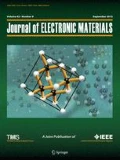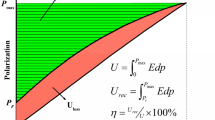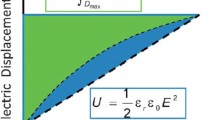Abstract
To test a theory of the recently discovered phenomenon of super dielectric behavior at very low frequency, the dielectric constants of several ‘pastes’, composed of porous alumina powders filled to the point of incipient wetness with water containing dissolved sodium chloride, were measured. The effective dielectric low frequency constants of some of the pastes were greater than 1010, dramatically higher than that of any material ever reported. Moreover, the total energy density reported for one capacitor generated with NaCl-based super dielectric material is marginally higher than found in any prior report. These results are consistent with this recently postulated model of low frequency super dielectric behavior in porous, non-conductive materials saturated with ion-containing liquids: upon the application of an electric field, ions dissolved in the saturating liquid contained in the pores will travel to the ends of pore-filling liquid droplets creating giant dipoles. The fields of these giant dipoles oppose the applied field, reducing the net field created per unit of charge on the capacitor plates, effectively increasing charge/voltage ratio, hence capacitance. This is simply a version of the theory of ‘polarizable media’ found in most classic texts on electromagnetism. Other observations reported here include (1) the impact of ion concentration on dielectric values, (2) a maximum voltage similar to that associated with the electrical breakdown of water, (3) the loss of capacitance upon drying, (4) the recovery of capacitance upon the addition of water to a dry super dielectric material, and (5) the linear relationship between capacitance and inverse thickness. All observations are consistent with the earlier proposed model of the super dielectric phenomenon. An extrapolation of results suggests this technology can lead to energy density greater than the best lithium-ion battery.
Similar content being viewed by others
References
S. Fromille and J. Phillips, Materials 7, 8197 (2014).
S. Fromille and J. Phillips, Superdielectric Materials, arXiv:1403.6862, (2014).
J.D. Jackson, Classical Electrodynamics, 2nd ed. (New York: Wiley, 1975).
C.G. Liu, M. Liu, F. Li, and H.M. Cheng, App. Phys. Lett. 92, 143108 (2008).
H. Gualous, D. Bouquain, A. Berthon, and J.M. Kauffmann, J. Power Sources 123, 86 (2003).
G.J. Reynolds, M. Krutzer, M. Dubs, H. Felzer, and R. Mamazza, Materials 5, 644 (2012).
E. Barsoukov and J. Ross MacDonald, Impedance Spectroscopy Theory, Experimental and Applications, 2nd ed. (New York: Wiley, 2005), p. 4.
I.D. Raistrick, D. Franceschetti, and J. Ross MacDonald, Impedance Spectroscopy.Emphasizing Solid Materials and Systems, ed. J. Ross Macdonald (New York: Wiley, 1987), p. 27.
R. Waser and O. Lohse, Science and Technology of Integrated Ferroelectrics: Selected Papers from 11 years of the International Symposium on Integrated Ferroelectrics, ed. C.P. de Aranjo, R. Ramedi, and G.W. Taylor, (CRC Press, 2001) pp. 501.
Personal Communication. Prof. Yun Liu, College of Physical and Mathematical Sciences, Australia National University, Canberra Australia.(Values based on impedance spectroscopic investigation of capacitors generated according to the authors specification and using author supplied material).
J. Phillips, B. Clausen, and J.A. Dumesic, J. Phys. Chem. 84, 1814 (1980).
J. Phillips and J.A. Dumesic, Appl. Surf. Sci. 7, 215 (1981).
P. Lunkenheimer, R. Fichtl, S.G. Ebbinghaus, and A. Loidl, Phys. Rev. B 70, 172102 (2004).
K. Kinoshita and A. Yamaji, J. Appl. Phys. 47, 371 (1976).
G. Arlt, D. Hennings, and G. de With, J. Appl. Phys. 58, 1619 (1985).
J.C. Burfoot and G.W. Taylor, Polar Dielectrics and Their Applications (Berkeley: University of California Press, 1979), pp. 359–397.
F. El Kamel and P. Gonon, J. Electrochem. Soc. 157, G91 (2010).
M. Maglione, C. Elissalde, and U.-C. Chung, Proc. SPIE 7603, 76030U (2010).
C. Pecharroman, F. Esteban-Betegon, F. Bartolome, J.F. Lopez-Esteban, and J. Moya, Adv. Mat. 13, 1541 (2001).
C. Pecharroman, F. Esteban-Betegon, and R. Jimenez, Ferroelectrics 400, 81 (2010).
S.K. Saha, Phys. Rev. B 69, 125416 (2004).
M. Valant, A. Dakskobler, M. Ambrozic, and T. Kosmac, J. Eur. Cer. Soc 26, 891 (2006).
I.P. Gor’kov and G.M. Eliashberg, Zh. Eksp. Teor. Fiz. 48, 1407 (1965) [Soviet Physics JETP 21, 940 (1965)].
D.J. Bergman and Y. Imry, Phys. Rev. Lett. 39, 1222 (1977).
A.L. Efros and B.I. Shklovskii, Phys. Stat. Sol. B 76, 475 (1976).
A.L. Efros, Phys. Rev. B 84, 155134 (2011).
D.L. Gerenrot, L. Berlyand, and J. Phillips, IEEE Trans. Adv. Packag. 26, 410 (2003).
A.A. Samara, W.F. Hammetter, and E.L. Venturini, Phys. Rev. B 41, 8974 (1990).
C.M. Rey, H. Mathias, L.R. Testardi, and S. Skirius, Phys. Rev. B 45, 10639 (1992).
Y. Yang, X. Wang, and B. Liu, J. Mat. Sci. 25, 146 (2014).
P. Lunkenheimer, S. Krohns, S. Riegg, S.G. Ebbinghaus, A. Reller, and A. Loidl, Eur. Phys. J. 180, 61 (2009).
P. Lunkenheimer, V. Bobnar, A.V. Pronin, A.I. Ritus, A.A. Volkov, and A. Lodl, Phys. Rev. B 66, 052105 (2002).
H.M. Jones and E.E. Kunhards, IEEE Trans. DEI 1, 1016 (1994).
Y. Toriyama and U. Shinohara, Phys. Rev. 51, 680 (1937).
T. Christen and M.W. Carlen, J. Power Sources 91, 210 (2000).
Author information
Authors and Affiliations
Corresponding author
Rights and permissions
About this article
Cite this article
Cortes, F.J.Q., Phillips, J. Novel Materials with Effective Super Dielectric Constants for Energy Storage. J. Electron. Mater. 44, 1367–1376 (2015). https://doi.org/10.1007/s11664-015-3641-8
Received:
Accepted:
Published:
Issue Date:
DOI: https://doi.org/10.1007/s11664-015-3641-8




